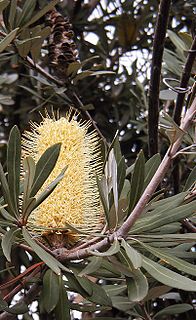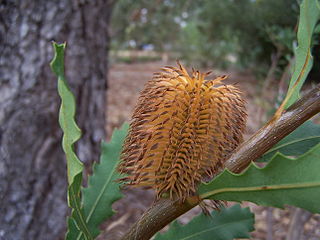
Banksia subg. Banksia is a valid botanic name for a subgenus of Banksia. As an autonym, it necessarily contains the type species of Banksia, B. serrata. Within this constraint, however, there have been various circumscriptions.

Banksia spinulosa, the hairpin banksia, is a species of woody shrub, of the genus Banksia in the family Proteaceae, native to eastern Australia. Widely distributed, it is found as an understorey plant in open dry forest or heathland from Victoria to northern Queensland, generally on sandstone though sometimes also clay soils. It generally grows as a small shrub to 2 metres (7 ft) in height, though can be a straggly tree to 6 metres (20 ft). It has long narrow leaves with inflorescences which can vary considerably in coloration; while the spikes are gold or less commonly yellowish, the emergent styles may be a wide range of colours – from black, purple, red, orange or yellow.

As with other flowering plants, the taxonomy of Banksia has traditionally been based on anatomical and morphological properties of the Banksia flower, fruiting structure and seed, along with secondary characteristics such as leaf structure and growth habit. Increasingly, molecular evidence from DNA is providing important new insights into relationships within the genus and between this and other genera in the Proteaceae.

Banksia dryandroides, the dryandra-leaved banksia, is a species of small shrub in the plant genus Banksia. The Noongar peoples know the tree as manyat. It occurs in shrubland, woodland and kwongan on the south coast of Western Australia between Narrikup and Beaufort Inlet. The species is placed alone in series B. ser. Dryandroideae.

Banksia nutans, commonly known as nodding banksia, is a species of shrub native to the south coast of Western Australia in the genus Banksia. Growing to a metre (3 ft) tall, it has pale blue-green fine-leaved foliage and unusual purple-brown inflorescences which hang upside down rather than grow upright like most other banksias.

Banksia violacea, commonly known as violet banksia, is a species of shrub or tree in the plant genus Banksia. It generally grows as a small shrub to 1.5 m (5 ft) high with fine narrow leaves, and is best known for its unusually coloured dark purple-violet inflorescences. The colour of the inflorescences, short leaves, and flattened follicles which are sticky when young, help identify this species from others in the field. It is found in low shrubland in southern regions of Western Australia from Esperance in the east to Narrogin in the west, growing exclusively in sandy soils.

Banksia ser. Dryandroideae is a taxonomic series in the plant genus Banksia. First published by Carl Meissner in 1856, the name has had two circumscriptions. As presently circumscribed it is monotypic, containing only B. dryandroides.

Banksia ser. Abietinae is a valid botanic name for a series of Banksia. First published by Carl Meissner in 1856, the name has had three circumscriptions.

Banksia ser. Salicinae is a valid botanic name for a series of Banksia. First published by Carl Meissner in 1856, the name has had three circumscriptions.

Banksia ser. Quercinae is a valid botanic name for a series of Banksia. First published by Carl Meissner in 1856, the name has had three circumscriptions.

Banksia ser. Cyrtostylis is a taxonomic series within the plant genus Banksia. First published at sectional rank by George Bentham in 1870, it was demoted to a series by Alex George in 1981. The name has had three circumscriptions.

Banksia ser. Banksia is a valid botanic name for a series of Banksia. As an autonym, it necessarily contains the type species of Banksia, B. serrata. Within this constraint, however, there have been various circumscriptions.

George Bentham's taxonomic arrangement of Banksia was published in 1870, in Volume 5 of Bentham's Flora Australiensis. A substantial improvement on the previous arrangement, it would stand for over a century. It was eventually replaced by Alex George's 1981 arrangement, published in his classic monograph The genus Banksia L.f. (Proteaceae).
Kevin Thiele and Pauline Ladiges taxonomic arrangement of Banksia, published in 1996, was a novel taxonomic arrangement that was intended to align the taxonomy of Banksia more closely with the phylogeny that they had inferred from their cladistic analysis of the genus. It replaced Alex George's 1981 arrangement, but most aspects were not accepted by George, and it was soon replaced by a 1999 revision of George's arrangement. However some herbaria have continued to follow Thiele and Ladiges on some points.
Robert Brown's taxonomic arrangement of Banksia was published in his book of 1810, Prodromus Florae Novae Hollandiae et Insulae Van Diemen, and expanded in the supplement to that publication, Supplementum Primum Prodromi Florae Novae Hollandiae, in 1830. It was the first survey of Banksia species to be published, and included descriptions of a number of previously undescribed species.

Alex George's taxonomic arrangement of Banksia was the first modern-day arrangement for that genus. First published in 1981 in the classic monograph The genus Banksia L.f. (Proteaceae), it superseded the arrangement of George Bentham, which had stood for over a hundred years. It was overturned in 1996 by Kevin Thiele and Pauline Ladiges, but restored by George in 1999. A recent publication by Austin Mast and Kevin Thiele suggests that it will soon be overturned again.

Banksia spinulosa var. collina is a shrub that grows along the east coast of Australia, in Queensland and New South Wales. Commonly known as Hill Banksia or Golden Candlesticks, it is a taxonomic variety of B. spinulosa. It is a popular garden plant widely sold in nurseries.

Banksia neoanglica, commonly known as New England banksia is a shrub or small tree with leaves that are greenish on the upper surface, whitish with soft hairs on the lower side and spikes of flowers with styles that turn black as they open. It is similar to Banksia spinulosa and was formerly known as Banksia spinulosa var. neoanglica, but differs in that its leaves are wider and have margins that are not tightly turned under. It is found mainly along the eastern edge of the Great Dividing Range.

Banksia spinulosa var. cunninghamii, sometimes given species rank as Banksia cunninghamii, is a shrub that grows along the east coast of Australia, in Victoria and New South Wales. It is a fast-growing non-lignotuberous shrub or small tree infrequently cultivated.

Banksia subser. Sphaerocarpae is a valid botanic name for a subseries of Banksia. It was published by Kevin Thiele in 1996, but discarded by Alex George in 1999.




















